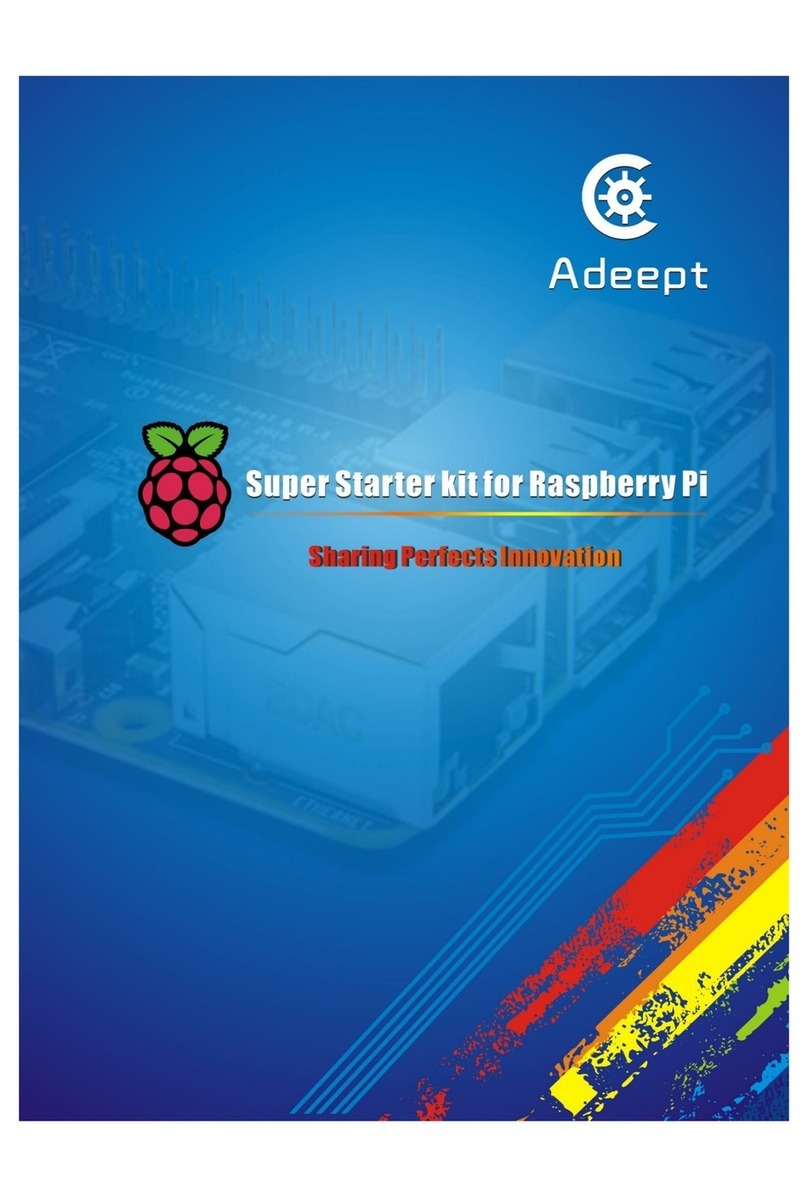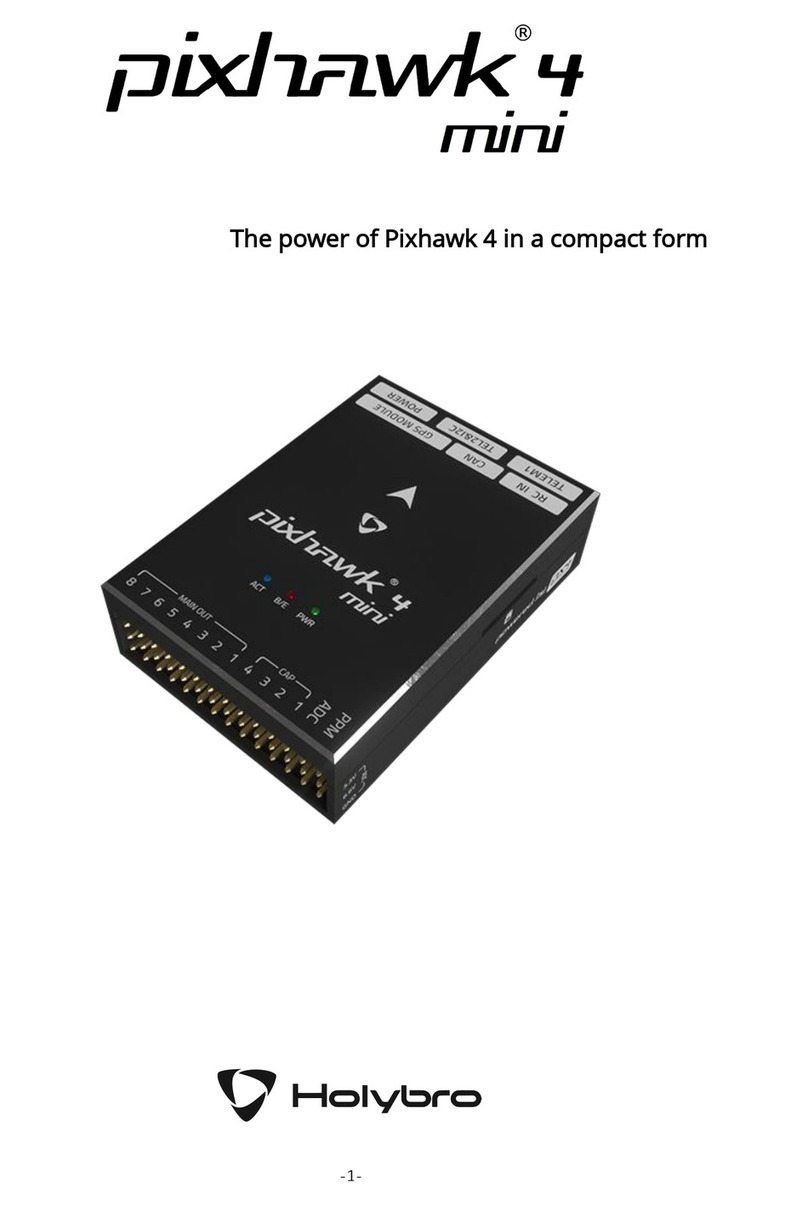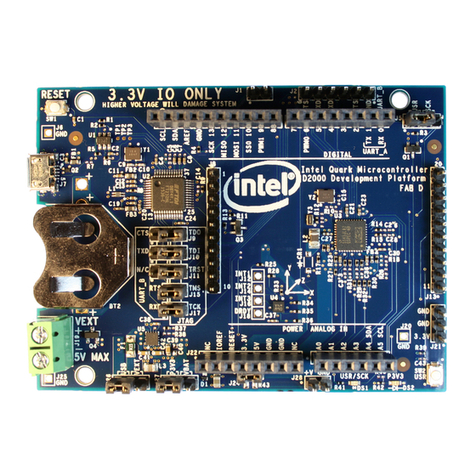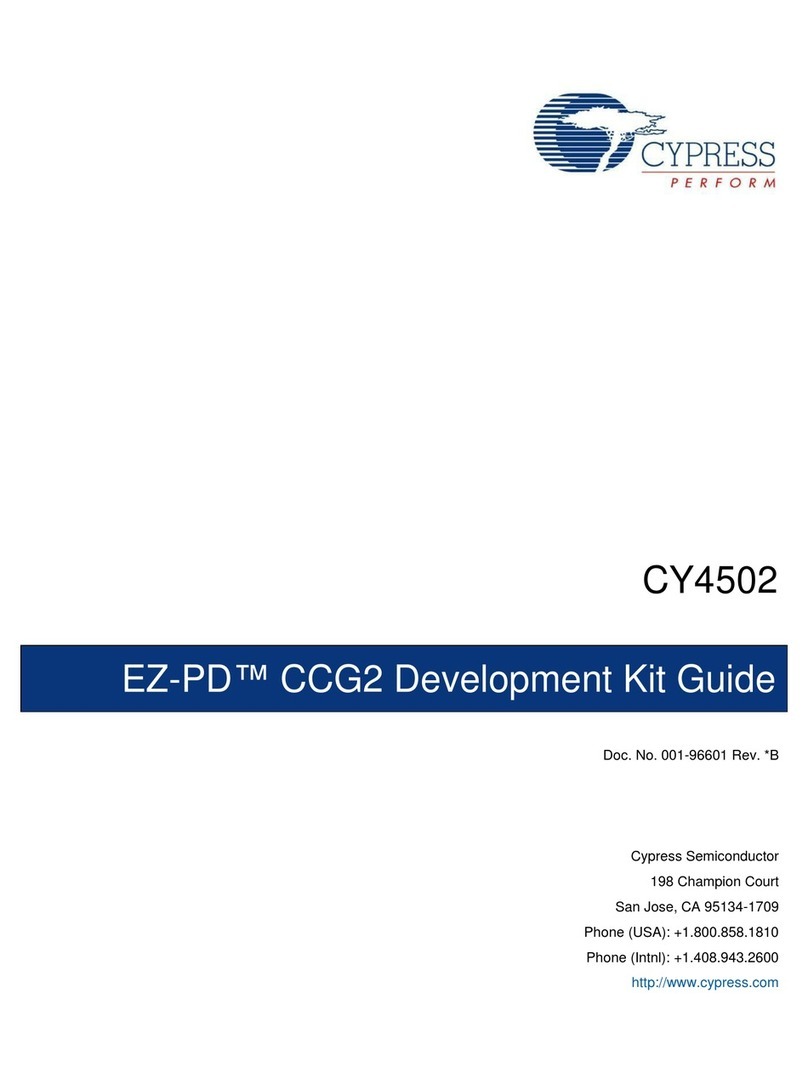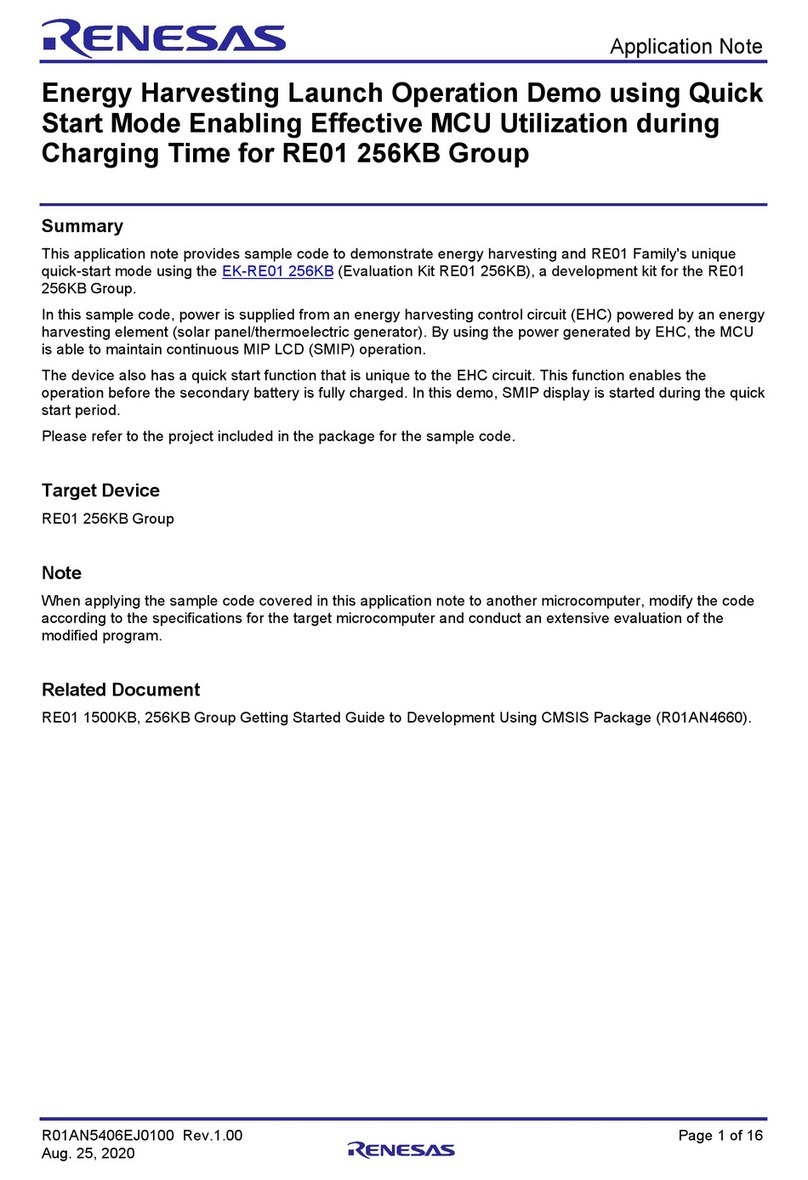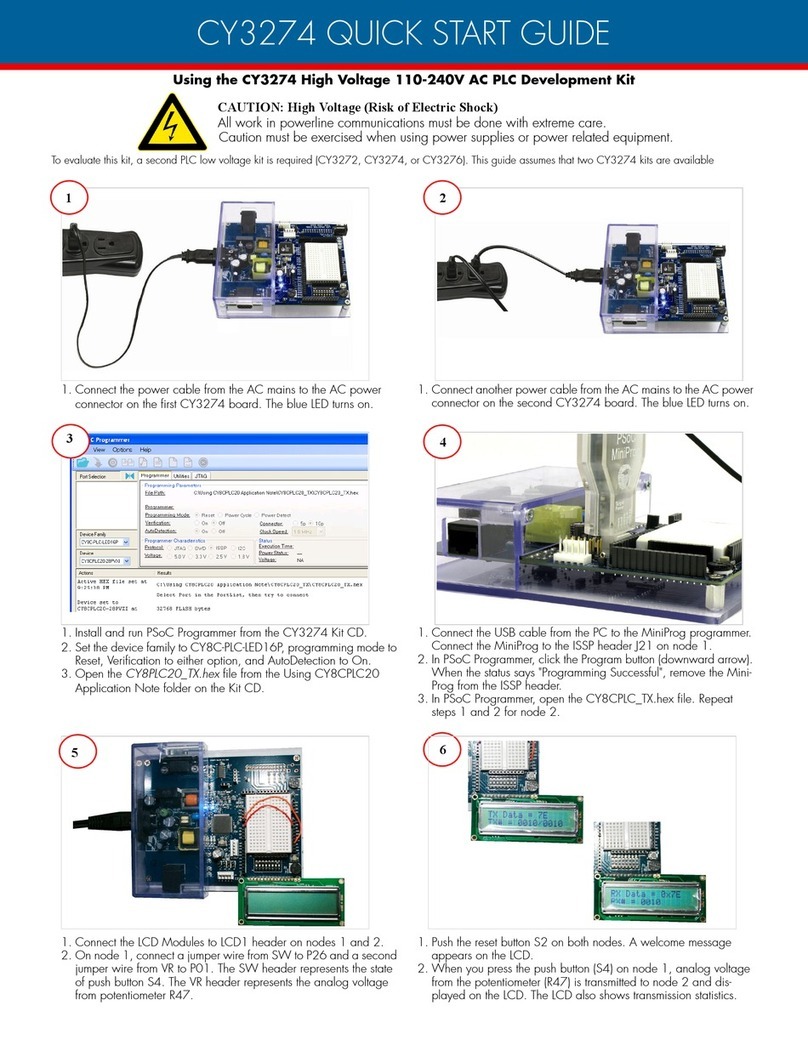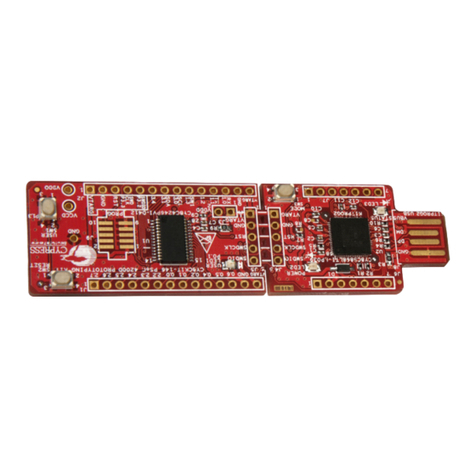Profichip VPC3+C User manual

VPC3+C
User Manual
Revision 1.03
The Clever Alternative

Liability Exclusion
We have tested the contents of this document regarding
agreement with the hardware and software described.
Nevertheless, there may be deviations and we do not
guarantee complete agreement. The data in the
document is tested periodically, however. Required
corrections are included in subsequent versions. We
gratefully accept suggestions for improvements.
Copyright
Copyright © profichip GmbH 2004-2006.
All Rights Reserved.
Unless permission has been expressly granted, passing
on this document or copying it, or using and sharing its
content are not allowed. Offenders will be held liable. All
rights reserved, in the event a patent is granted or a
utility model or design is registered.
This document is subject to technical changes.
2 Revision 1.03
VPC3+C User Manual
Copyright © profichip GmbH 2004-2006

Table of Contents
1Introduction.................................................................5
2Functional Description ...............................................7
2.1 Overview ......................................................................................7
3Pin Description............................................................9
3.1 Pin Assignment ............................................................................9
3.2 Pinout .........................................................................................11
4Memory Organization ...............................................13
4.1 Overview ....................................................................................13
4.2 Control Parameters (Latches/Registers) ....................................15
4.3 Organizational Parameters (RAM) .............................................17
5ASIC Interface............................................................19
5.1 Mode Registers ..........................................................................19
5.1.1 Mode Register 0 .............................................................19
5.1.2 Mode Register 1 .............................................................21
5.1.3 Mode Register 2 .............................................................23
5.2 Status Register...........................................................................25
5.3 Interrupt Controller .....................................................................27
5.3.1 Interrupt Request Register.............................................. 28
5.3.2 Interrupt Acknowledge / Mask Register .......................... 31
5.4 Watchdog Timer .........................................................................31
5.4.1 Automatic Baud Rate Identification................................. 32
5.4.2 Baud Rate Monitoring ..................................................... 32
5.4.3 Response Time Monitoring............................................. 32
6PROFIBUS DP Interface............................................35
6.1 DP Buffer Structure ....................................................................35
6.2 Description of the DP Services...................................................38
6.2.1 Set_Slave_Add (SAP 55) ...............................................38
6.2.2 Set _Prm (SAP 61) .........................................................39
6.2.3 Chk_Cfg (SAP 62) ..........................................................43
6.2.4 Slave_Diag (SAP 60)......................................................44
6.2.5 Write_Read_Data / Data_Exchange (Default_SAP).......46
6.2.6 Global_Control (SAP 58) ................................................50
6.2.7 RD_Input (SAP 56) ......................................................... 51
6.2.8 RD_Output (SAP 57) ......................................................51
6.2.9 Get_Cfg (SAP 59)........................................................... 52
VPC3+C User Manual Revision 1.03 3
Copyright © profichip GmbH 2004-2006

Table of Contents
7PROFIBUS DP Extensions .......................................53
7.1 Set_(Ext_)Prm (SAP 53 / SAP 61) .............................................53
7.2 PROFIBUS DP-V1 .....................................................................54
7.2.1 Acyclic Communication Relationships ............................ 54
7.2.2 Diagnosis Model .............................................................57
7.3 PROFIBUS DP-V2 .....................................................................58
7.3.1 DXB (Data eXchange Broadcast) ...................................58
7.3.2 IsoM (Isochron Mode)..................................................... 64
8Hardware Interface....................................................69
8.1 Universal Processor Bus Interface .............................................69
8.1.1 Overview......................................................................... 69
8.1.2 Bus Interface Unit ...........................................................69
8.1.3 Application Examples (Principles) ..................................73
8.1.4 Application with 80C32 (2K Byte RAM Mode) ................75
8.1.5 Application with 80C32 (4K Byte RAM Mode) ................76
8.1.6 Application with 80C165 ................................................. 77
8.2 Dual Port RAM Controller...........................................................77
8.3 UART..........................................................................................78
8.4 ASIC Test ...................................................................................78
9PROFIBUS Interface..................................................79
9.1 Pin Assignment ..........................................................................79
9.2 Example for the RS485 Interface ...............................................80
10 Operational Specifications.......................................81
10.1 Absolute Maximum Ratings........................................................81
10.2 Recommended Operating Conditions ........................................81
10.3 General DC Characteristics........................................................81
10.4 Ratings for the Output Drivers....................................................82
10.5 DC Electrical Characteristics Specification for 5V Operation .....82
10.6 DC Electrical Characteristics Specification for 3.3V Operation ..83
10.7 Timing Characteristics................................................................84
10.7.1 System Bus Interface......................................................84
10.7.2 Timing in the Synchronous Intel Mode ........................... 85
10.7.3 Timing in the Asynchronous Intel Mode.......................... 87
10.7.4 Timing in the Synchronous Motorola Mode ....................89
10.7.5 Timing in the Asynchronous Motorola Mode .................. 91
10.8 Package .....................................................................................94
10.9 Processing Instructions ..............................................................96
4 Revision 1.03
VPC3+C User Manual
Copyright © profichip GmbH 2004-2006

Introduction 1
1 Introduction
Profichip’s VPC3+C is a communication chip with processor interface for
intelligent PROFIBUS DP-Slave applications. It’s an enhancement of the
VPC3+B in terms of protocol functions and power consumption.
The VPC3+C handles the message and address identification, the data
security sequences and the protocol processing for PROFIBUS DP. In
addition the acyclic communication and alarm messages, described in
DPV1 extension, are supported. Furthermore the slave-to-slave
communication Data eXchange Broadcast (DXB) and the Isochronous Bus
Mode (IsoM), described in DPV2 extension, are also provided.
Automatic recognition and support of data transmissions rates up to 12
Mbit/s, the integration of the complete PROFIBUS DP protocol, 4K Byte
communication RAM and the configurable processor interface are features
to create high-performance PROFIBUS DP-Slave applications. The device
can be operated with either 3.3V or 5V single supply voltage. For 3.3V
operation the inputs are 5V tolerant.
Profichip’s VPC3+ is the predecessor of VPC3+C and VPC3+B. The chip
offers 2 kByte communication RAM and PROFIBUS DP functionality only
and is therefore suited for DP-Slave applications which do not require
DP-V1 or DP-V2 functions. The device can be operated with 5V single
supply only.
VPC3+ and VPC3+C are pin-compatible. Therefore VPC3+ can be
replaced by VPC3+C in existing applications without any restrictions or SW-
modifications. However, downgrading from VPC3+C to VPC3+ is only
possible, if the additional features of VPC3+C (4K Byte RAM, DP-V1- or
DP-V2-functionality, 3.3V supply) are not used.
As there are also simple devices in the automation engineering area, such
as switches or thermoelements, that do not require a microcontroller for
data preprocessing, profichip offers a DP-Slave ASIC with 32 direct
input/output bits. The VPCLS2 handles the entire data traffic independently.
No additional microprocessor or firmware is necessary. The VPCLS2 is
compatible to existing chips.
Further information about our products or current and future projects is
available on our web page: http://www.profichip.com.
VPC3+C User Manual Revision 1.03 5
Copyright © profichip GmbH 2004-2006

1 Introduction
Notes:
6 Revision 1.03
VPC3+C User Manual
Copyright © profichip GmbH 2004-2006

Functional Description 2
2 Functional Description
2.1 Overview
The VPC3+C makes a cost optimized design of intelligent PROFIBUS DP-
Slave applications possible.
The processor interface supports the following processor series:
Intel: 80C31, 80X86
Siemens: 80C166/165/167
Motorola: HC11-, HC16-, and HC916 types
The VPC3+C handles the physical layer 1 and the data link layer 2 of the
ISO/OSI-reference-model excluding the analog RS485 drivers.
The integrated 4K Byte Dual-Port-RAM serves as an interface between
the VPC3+C and the software/application. In case of using 2K Byte the
entire memory is divided into 256 segments, with 8 bytes each. Otherwise
in the 4K Byte mode the segment base addresses starts at multiple of 16.
Addressing by the user is done directly, however, the internal Micro
Sequencer (MS) addresses the RAM by means of the so-called base-
pointer. The base-pointer can be positioned at the beginning of a segment
in the memory. Therefore, all buffers must be located at the beginning of a
segment.
If the VPC3+C carries out a DP communication it automatically sets up all
DP-SAPs. The various telegram information are made available to the user
in separate data buffers (for example, parameter and configuration data).
Three buffers are provided for data communication (three for output data
and three for input data). As one buffer is always available for communica-
tion no resource problems can occur. For optimal diagnosis support, the
VPC3+C offers two Diagnosis-Buffers. The user enters the updated
diagnosis data into these buffers. One Diagnosis-Buffer is always assigned
to the VPC3+C.
The Bus Interface Unit is a parameterizable synchronous/asynchronous 8-
bit interface for various Intel and Motorola microcontrollers/processors. The
user can directly access the internal 2K/4K Byte RAM or the parameter
latches and control registers via the 11/12-bit address bus.
Procedure-specific parameters (Station_Address, control bits, etc.) must be
transferred to the Parameter Registers and to the Mode Registers after
power-on.
The MAC status can be observed at any time in the Status Register.
Various events (e.g. various indications, error events, etc.) are entered in
the Interrupt Controller. These events can be individually enabled via a
mask register. Acknowledgement takes place by means of the acknowl-
edge register. The VPC3+C has a common interrupt output.
VPC3+C User Manual Revision 1.03 7
Copyright © profichip GmbH 2004-2006

2 Functional Description
The integrated Watchdog Timer is operated in three different states:
BAUD_SEARCH, BAUD_CONTROL and DP_CONTROL.
The Micro Sequencer (MS) controls the entire process. It contains the DP-
Slave state machine (DP_SM).
The integrated 4K Byte RAM that operates as a Dual-Port-RAM contains
procedure-specific parameters (buffer pointer, buffer lengths,
Station_Address, etc.) and the data buffers.
In the UART, the parallel data flow is converted into the serial data flow and
vice-versa. The VPC3+C is capable of automatically identifying the baud
rates (9.6 Kbit/s - 12 Mbit/s).
The Idle Timer directly controls the bus times on the serial bus line.
8 Revision 1.03
VPC3+C User Manual
Copyright © profichip GmbH 2004-2006

Pin Description 3
3 Pin Description
3.1 Pin Assignment
Pin Signal Name In/Out Description Source / Destination
XCS Chip-Select
C32 Mode (2K Byte RAM): connect to VDD
C165 Mode: CS-Signal
1
AB11
I(C)
Address Bus 11 (C32-Mode; 4K Byte RAM)
CPU (80C165)
XWR / E_CLOCK Write Signal / E_Clock for Motorola
2
AB11
I(C)
Address Bus 11 (Asynchronous Motorola Mode; 4K Byte RAM)
CPU
3 DIVIDER I(C)
Setting the scaling
factor for CLKOUT2/4
‘0’ = CLK divided by 4
’1’ = CLK divided by 2 Configuration Pin
4 XRD / R_W I(C) Read Signal / Read _Write for Motorola CPU
5 CLK I(TS) System Clock Input, 48 MHz System
6 VSS
7 CLKOUT2/4 O Clock Output (System Clock divided by 2 or 4) System, CPU
8 XINT/MOT I(C)
‘0’ = Intel Interface
’1’ = Motorola Interface Configuration Pin
9 X/INT O Interrupt CPU; Interrupt-
Controller
10 AB10 I(CPD) Address Bus C32 Mode: ‘0’
C165 Mode: Address Bus System, CPU
11 DB0 I(C)/O
12 DB1 I(C)/O
Data Bus C32 Mode: Data/Address Bus multiplexed
C165 Mode: Data/Address Bus separated CPU, Memory
XDATAEXCH Indicates DATA-EXCH state for PROFIBUS DP LED
13 SYNC O Synchronization Signal for Isochron Mode (see section 8.3.2) CPU
14 XREADY/XDTACK O Ready for external CPU System, CPU
15 DB2 I(C)/O
16 DB3 I(C)/O
Data Bus C32 mode: Data /Address Bus multiplexed
C165 mode: Data/Address Bus separate CPU, Memory
17 VSS
18 VDD
19 DB4 I(C)/O
20 DB5 I(C)/O
21 DB6 I(C)/O
22 DB7 I(C)/O
Data Bus C32 mode: Data/Address Bus multiplexed
C165 mode: Data/Address Bus separate CPU, Memory
23 MODE I ‘0’ = 80C166 Data/Address Bus separated; Ready Signal
’1’ = 80C32 Data/Address Bus multiplexed, fixed Timing Configuration Pin
ALE / AS Address Latch
Enable
C32 mode: ALE
C165 mode: ‘0’ (2K Byte RAM)
24
AB11
I(C) Address Bus 11 (Asynchronous Intel and
Synchronous Motorola Mode; 4K Byte RAM)
CPU
25 AB9 I Address Bus C32 Mode: <log>0
C165 Mode: Address Bus CPU, Memory
26 TXD O Serial Transmit Port PROFIBUS Interface
27 RTS O Request to Send PROFIBUS Interface
28 VSS
29 AB8 I(C) Address Bus C32 mode: ‘0’
C165 mode: Address Bus CPU, Memory
VPC3+C User Manual Revision 1.03 9
Copyright © profichip GmbH 2004-2006

3 Pin Description
Pin Signal Name In/Out Description Source / Destination
30 RXD I(C) Serial Receive Port PROFIBUS Interface
31 AB7 I(C)
32 AB6 I(C) Address Bus CPU, Memory
33 XCTS I(C) Clear to Send: ‘0’ = send enable FSK Modem
34 XTEST0 I(C) Pin must be connected to VDD.
35 XTEST1 I(C) Pin must be connected to VDD.
36 RESET I(CS) Connect Reset Input with CPU’s port pin.
37 AB4 I(C) Address Bus CPU, Memory
38 VSS
39 VDD
40 AB3 I(C)
41 AB2 I(C)
42 AB5 I(C)
43 AB1 I(C)
44 AB0 I(C)
Address Bus CPU, Memory
Figure 3-1: Pin Assignment
Notes:All signals that begin with X.. are LOW active.
C32-Mode means ‘Synchronous Intel Mode’ and
C165-Mode means ‘Asynchronous Intel Mode’.
VDD = +5 V
VSS = 0 V
Input Levels:
I ( C ) : CMOS
I ( CS ) : CMOS, Schmitt-Trigger
I (CPD ) : CMOS, pulldown
I (TS ) : TTL, Schmitt-Trigger
4K Byte RAM extension
Beginning with Step B of the VPC3+ the communication RAM has been
extended to 4K Byte, whereas Step A only has 2K Byte. To access the
entire 4K Byte RAM in VPC3+C an additional address signal AB11 is
required. Which pin is assigned to A11 depends on the Processor Interface
Mode used (see Figure 3-2). Due to compatibility reasons the pin which is
now assigned to A11 was unused in Step A for the certain Interface Mode.
Processor Interface Mode Pin Signal Name
Synchronous Intel Mode 1 XCS
Asynchronous Intel Mode 24 ALE/AS
Asynchronous Motorola Mode 2 XWR/E_CLOCK
Synchronous Motorola Mode 24 ALE/AS
Figure 3-2 : Pin assignment for AB11
The 4K Byte RAM extension must be enabled in Mode Register 2 (see
section 5.1.3). By default the 4K Byte mode is disabled.
10 Revision 1.03
VPC3+C User Manual
Copyright © profichip GmbH 2004-2006

Pin Description 3
3.2 Pinout
VPC3+C has a 44-pin PQFP housing with the following pinout:
DB7
DB6
DB5
DB4
VDD
VSS
DB3
DB2
XREADY/XDTACK
XDATAEXCH/SYNC
DB1
XCS/AB11
X
WR/E_CLOCK/AB11
DIVIDER
XRD/R_W
CLK
VSS
CLCKOUT2/4
XINT/MOT
X/INT
AB10
DB0
XCTS
AB6
AB7
RXD
AB8
VSS
RTS
TXD
AB9
ALE/AS/AB11
MODE
XTEST0
XTEST1
RESET
AB4
VSS
VDD
AB3
AB2
AB5
AB1
AB0
111
12
22
2333
34
44
Figure 3-3: VPC3+C Pinout
For details about package outline and dimensions see section 10.8.
VPC3+C User Manual Revision 1.03 11
Copyright © profichip GmbH 2004-2006

3 Pin Description
Notes:
12 Revision 1.03
VPC3+C User Manual
Copyright © profichip GmbH 2004-2006

Memory Organization 4
4 Memory Organization
4.1 Overview
The internal Control Parameters are located in the first 21 addresses. The
latches/registers either come from the internal controller or influence the
controller. Certain cells are read- or write-only. The internal working cells,
which are not accessible by the user, are located in RAM at the same
address locations.
The Organizational Parameters are located in RAM beginning with address
16H. The entire buffer structure (for the DP-SAPs) is based on these pa-
rameters. In addition, general parameter data (Station_Address,
Ident_Number, etc.) and status information (Global_Control command, etc.)
are also stored in these cells.
Corresponding to the parameter setting of the Organizational Parameters,
the user-generated buffers are located beginning with address 40H. All
buffers or lists must begin at segment addresses (8 bytes segmentation for
2K Byte mode, 16 bytes segmentation for 4K Byte mode).
Address Function
000H
:
015H
Control Parameters
(latches/registers) (21 bytes) Internal working cells
016H
:
03FH
Organizational Parameters (42 bytes)
040H
:
7FFH (FFFH)
DP-buffers: Data in (3)*
Data out (3)**
Diagnosis data(2)
Parameter data (1)
Configuration data (2)
Auxiliary buffers (2)
SSA-buffer (1)
DP-V1-buffer: SAP-List (1)
Indication / Response buffers ***
DP-V2-buffer: DXB out (3)****
DXB-buffers (2)
CS-buffers (1)
Figure 4-1: Memory Table
* Data in means input data from DP-Slave to DP-Master
** Data out means output data from DP-Master to DP-Slave
*** number of buffers depends on the entries in the SAP-List
**** DXB out means input data from another DP-Slave (slave-to-slave communication)
VPC3+C User Manual Revision 1.03 13
Copyright © profichip GmbH 2004-2006

4 Memory Organization
Internal VPC3+C RAM (2K/4K Byte)
Segment 0
Segment 1
Segment 2
8/16 bit segment addresses
(pointer to the buffers)
Segment 254
Segment 255
Building of the physical buffer address:
2K Byte Mode:
7 0
Segment base address (8 bit)
0 0 0 0 0 Offset (3 bit)
+
10 0
Physical address (11 bit)
4K Byte Mode:
7 0
Segment base address (8 bit)
0 0 0 0 Offset (4 bit)
+
11 0
Physical address (12 bit)
14 Revision 1.03
VPC3+C User Manual
Copyright © profichip GmbH 2004-2006

Memory Organization 4
4.2 Control Parameters (Latches/Registers)
These cells can be either read-only or write-only. In the Motorola Mode the
VPC3+C carries out ‘address swapping’ for an access to the address
locations 00H - 07H (word registers). That is, the VPC3+C internally
generates an even address from an odd address and vice-versa.
Address
Intel Mot. Name Bit No. Significance (Read Access!)
00H 01H
Int-Req-Reg 7..0
01H 00H
Int-Req-Reg 15..8
02H 03H
Int−Reg 7..0
03H 02H
Int−Reg 15..8
Interrupt Controller Register
04H 05H
Status-Reg 7..0
05H 04H
Status-Reg 15..8
Status Register
06H 07H
Mode-Reg 0 7..0
07H 06H
Mode-Reg 0 15..8 Mode Register 0
08H Din_Buffer_SM 7..0
Buffer assignment of the
DP_Din_Buffer_State_Machine
09H New_Din_Buffer_Cmd 1..0
The user makes a new DP Din_Buf
available in the N state.
0AH Dout_Buffer_SM 7..0
Buffer assignment of the
DP_Dout_Buffer_State_Machine
0BH Next_Dout_Buffer_Cmd 3..0
The user fetches the last DP
Dout_Buf from the N state
0CH Diag_Buffer_SM 3..0
Buffer assignment for the
DP_Diag_Buffer_State_Machine
0DH New_Diag_Buffer_Cmd 1..0
The user makes a new DP
Diag_Buf available to the VPC3+C.
0EH User_Prm_Data_Okay 1..0
The user positively acknowledges
the user parameter setting data of a
Set_(Ext_)Prm telegram.
0FH User_Prm_Data_Not_Okay 1..0
The user negatively acknowledges
the user parameter setting data of a
Set_(Ext_)Prm telegram.
10H User_Cfg_Data_Okay 1..0
The user positively acknowledges
the configuration data of a Chk_Cfg
telegram.
11H User_Cfg_Data_Not_Okay 1..0
The user negatively acknowledges
the configuration data of a Chk_Cfg
telegram.
12H DXBout_Buffer_SM 7..0
Buffer assignment of the
DXBout_Buffer_State_Machine
13H Next_DXBout_Buffer_Cmd 2..0 The user fetches the last
DXBout Buf from the N state
14H SSA_Buffer_Free_Cmd
The user has fetched the data from
the SSA_Buf and enables the buffer
again.
15H Mode-Reg 1 7..0
Figure 4-2: Assignment of the Internal Parameter-Latches for READ
VPC3+C User Manual Revision 1.03 15
Copyright © profichip GmbH 2004-2006

4 Memory Organization
Address
Intel Mot.
Name Bit No. Significance (Write Access!)
00H 01H Int-Req-Reg 7..0
01H 00H Int-Req_Reg 15..8
02H 03H Int-Ack-Reg 7..0
03H 02H Int-Ack-Reg 15..8
04H 05H Int−Mask-Reg 7..0
05H 04H Int−Mask-Reg 15..8
Interrupt-Controller-Register
06H 07H Mode-Reg0 7..0
07H 06H Mode-Reg0 15..8
Setting parameters for individual bits
08H Mode-Reg1-S 7..0
09H Mode-Reg1-R 7..0
0AH WD_BAUD_CONTROL_Val 7..0
Square-root value for
baud rate monitoring
0BH minTSDR_Val 7..0
minTSDR time
0CH Mode-Reg2 7..0
Mode Register 2
0DH Sync_PW_Reg 7..0 Sync Pulse Width Register
0EH Control_Command_Reg 7..0
Control_Command value for
comparison with SYNCH telegram
0FH Group_Select_Reg 7..0
Group_Select value for comparison
with SYNCH telegram
10H
11H
12H
13H
14H
15H
Reserved
Figure 4-3: Assignment of the Internal Parameter-Latches for WRITE
16 Revision 1.03
VPC3+C User Manual
Copyright © profichip GmbH 2004-2006

Memory Organization 4
4.3 Organizational Parameters (RAM)
The user stores the organizational parameters in the RAM under the
specified addresses. These parameters can be written and read.
Address
Intel Mot.
Name Bit No. Significance
16H R_TS_Adr Setup Station_Address of the VPC3+C
17H SAP_List_Ptr Pointer to a RAM address which is preset
with FFh or to SAP-List
18H 19H R_User_WD_Value 7..0
19H 18H R_User_WD_Value 15..8
In DP_Mode an internal 16-bit watchdog
timer monitors the user.
1AH R_Len_Dout_Buf Length of the 3 Dout_Buf
1BH R_Dout_Buf_Ptr1 Segment base address of Dout_Buf 1
1CH R_Dout_Buf_Ptr2 Segment base address of Dout_Buf 2
1DH R_Dout_Buf_Ptr3 Segment base address of Dout_Buf 3
1EH R_Len_Din_Buf Length of the 3 Din_Buf
1FH R_Din_Buf_Ptr1 Segment base address of Din_Buf 1
20H R_Din_Buf_Ptr2 Segment base address of Din_Buf 2
21H R_Din_Buf_Ptr3 Segment base address of Din_Buf 3
22H R_Len_DXBout_Buf Length of the 3 DXBout_Buf
23H R_DXBout_Buf_Ptr1 Segment base address of DXBout_Buf 1
24H R_Len Diag_Buf1 Length of Diag_Buf 1
25H R_Len Diag_Buf2 Length of Diag_Buf 2
26H R_Diag_Buf_Ptr1 Segment base address of Diag_Buf 1
27H R_Diag_Buf_Ptr2 Segment base address of Diag_Buf 2
28H R_Len_Cntrl_Buf1
Length of Aux_Buf 1 and the
corresponding control buffer, for example
SSA_Buf, Prm_Buf, Cfg_Buf,
Read_Cfg_Buf
29H R_Len_Cntrl_Buf2
Length of Aux_Buf 2 and the
corresponding control buffer, for example
SSA_Buf, Prm_Buf, Cfg_Buf,
Read_Cfg_Buf
2AH R_Aux_Buf_Sel
Bit array; defines the assignment of the
Aux_Buf 1 and 2 to the control buffers
SSA_Buf, Prm_Buf, Cfg_Buf
2BH R_Aux_Buf_Ptr1 Segment base address of Aux_Buf 1
2CH R_Aux_Buf_Ptr2 Segment base address of Aux_Buf 2
2DH R_Len_SSA_Data Length of the input data in the
Set_Slave_Address_Buf
2EH R_SSA_Buf_Ptr Segment base address of the
Set_Slave_Address_Buf
2FH R_Len_Prm_Data Length of the input data in the Prm_Buf
VPC3+C User Manual Revision 1.03 17
Copyright © profichip GmbH 2004-2006

4 Memory Organization
Address
Intel Mot.
Name Bit No. Significance
30H R_Prm_Buf_Ptr Segment base address of the Prm_Buf
31H R_Len_Cfg_Data Length of the input data in the Cfg_Buf
32H R_Cfg_Buf_Ptr Segment base address of the Cfg_Buf
33H R_Len_Read_Cfg_Data Length of the input data in the
Read_Cfg_Buf
34H R_Read_Cfg_Buf_Ptr Segment base address of the
Read_Cfg_Buf
35H R_Len_DXB_Link_Buf Length of the DXB_Linktable
36H R_DXB_Link_Buf_Ptr Segment base address of the
DXB_Link_Buf
37H R_Len_DXB_Status_Buf Length of the DXB_Status
38H R_DXB_Status_Buf_Ptr Segment base address of the
DXB_Status_Buf
39H R_Real_No_Add_Change
This parameter specifies whether the
Station_Address may be changed again
later.
3AH R_Ident_Low The user sets the parameters for the
Ident_Number_Low value.
3BH R_Ident_High The user sets the parameters for the
Ident_Number_High value.
3CH R_GC_Command The Control_Command of Global_Control
last received
3DH R_Len_Spec_Prm_Buf
If parameters are set for the
Spec_Prm_Buffer_Mode (see Mode
Register 0), this cell defines the length of
the Prm_Buf.
3EH R_DXBout_Buf_Ptr2 Segment base address of DXBout_Buf 2
3FH R_DXBout_Buf_Ptr3 Segment base address of DXBout_Buf 3
Figure 4-4: Assignment of the Organizational Parameters
18 Revision 1.03
VPC3+C User Manual
Copyright © profichip GmbH 2004-2006

ASIC Interface 5
5 ASIC Interface
5.1 Mode Registers
In the VPC3+C parameter bits that access the controller directly or which
the controller directly sets are combined in three Mode Registers (0, 1 and
2).
5.1.1 Mode Register 0
Setting parameters for Mode Register 0 may take place in the Offline
state only (for example, after power-on). The VPC3+C may not exit the
Offline state until Mode Register 0, all Control and Organizational Pa-
rameters are loaded (START_VPC3 = 1 in Mode Register 1).
Bit Position
Address 7 6 5 4 3 2 1 0 Designation
06H
(Intel)
Freeze_
Supported
Sync_
Supported
Early_Rdy
Int_Pol
minTSDR
WD_Base
Dis_Stop_
Control
Dis_Start_
Control
Mode Reg 0
7 .. 0
See below for
coding
Bit Position
Address 15 14 13 12 11 10 9 8 Designation
07H
(Intel)
Reserved
PrmCmd_
Supported
Spec_Clear_
Mode *)
Spec_Prm_
Buf_Mode **)
Set_Ext_Prm
_Supported
User_Time_
Base
EOI_Time_
Base
DP_Mode
Mode Reg 0
15 .. 8
See below for
coding
*) If Spec_Clear_Mode = 1 (Fail Safe Mode) the VPC3+C will accept Data_Exchange
telegrams without any output data (data unit length = 0) in the state DATA-EXCH. The
reaction to the outputs can be parameterized in the parameterization telegram.
**) When a large number of parameters have to be transmitted from the DP-Master to the
DP-Slave, the Aux-Buffer 1/2 must have the same length as the Parameter-Buffer.
Sometimes this could reach the limit of the available memory in the VPC3+C. When
Spec_Prm_Buf_Mode = 1 the parameterization data are processed directly in this special
buffer and the Aux-Buffers can be held compact.
VPC3+C User Manual Revision 1.03 19
Copyright © profichip GmbH 2004-2006

5 ASIC Interface
Mode Register 0, Low-Byte, Address 06H (Intel):
bit 7 Freeze_Supported: Freeze_Mode support
0 = Freeze_Mode is not supported.
1 = Freeze_Mode is supported
bit 6 Sync_Supported: Sync_Mode support
0 = Sync_Mode is not supported.
1 = Sync_Mode is supported.
bit 5 Early_Rdy: Early Ready
0 = Normal Ready: Ready is generated when data is valid (write) or when data
has been accepted (read).
1 = Ready is generated one clock pulse earlier
bit 4 INT_Pol: Interrupt Polarity
0 = The interrupt output is low-active.
1 = The interrupt output is high-active.
bit 3 minTSDR:Default setting for the minTSDR after reset for DP operation or
combi operation.
0 = Pure DP operation (default configuration!)
1 = Combi operation
bit 2 WD_Base: Watchdog Time Base
0 = Watchdog time base is 10 ms (default state)
1 = Watchdog time base is 1 ms
bit 1 Dis_Stop_Control: Disable Stopbit Control
0 = Stop bit monitoring is enabled.
1 = Stop bit monitoring is switched off
Set_Prm telegram overwrites this memory cell in the DP_Mode. (Refer to the
user specific data.)
bit 0 Dis_Start_Control: Disable Startbit Control
0 = Monitoring the following start bit is enabled.
1 = Monitoring the following start bit is switched off
Set_Prm telegram overwrites this memory cell in the DP_Mode. (Refer to the
user specific data.)
Figure 5-1: Coding of Mode Register 0, Low-Byte
20 Revision 1.03
VPC3+C User Manual
Copyright © profichip GmbH 2004-2006
Table of contents
Popular Microcontroller manuals by other brands
Silicon Laboratories
Silicon Laboratories UG338 user guide
Freescale Semiconductor
Freescale Semiconductor Kinetis TWR-K21D50M quick start guide
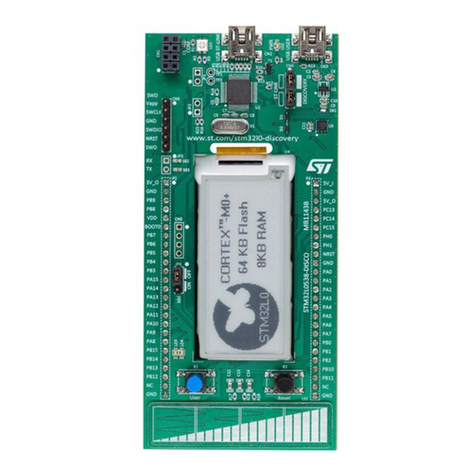
ST
ST STM32F0 Series Application note
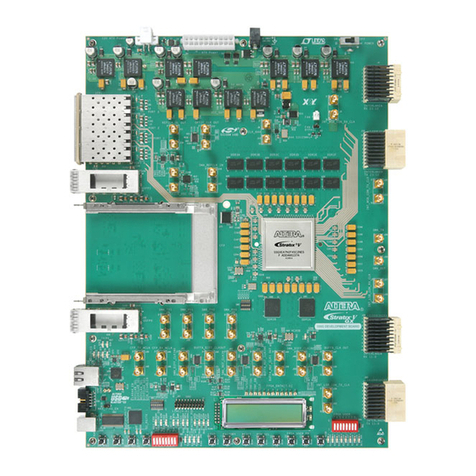
Altera
Altera Stratix V GX 100G Reference manual

Motorola
Motorola G24 Guide Developer's guide
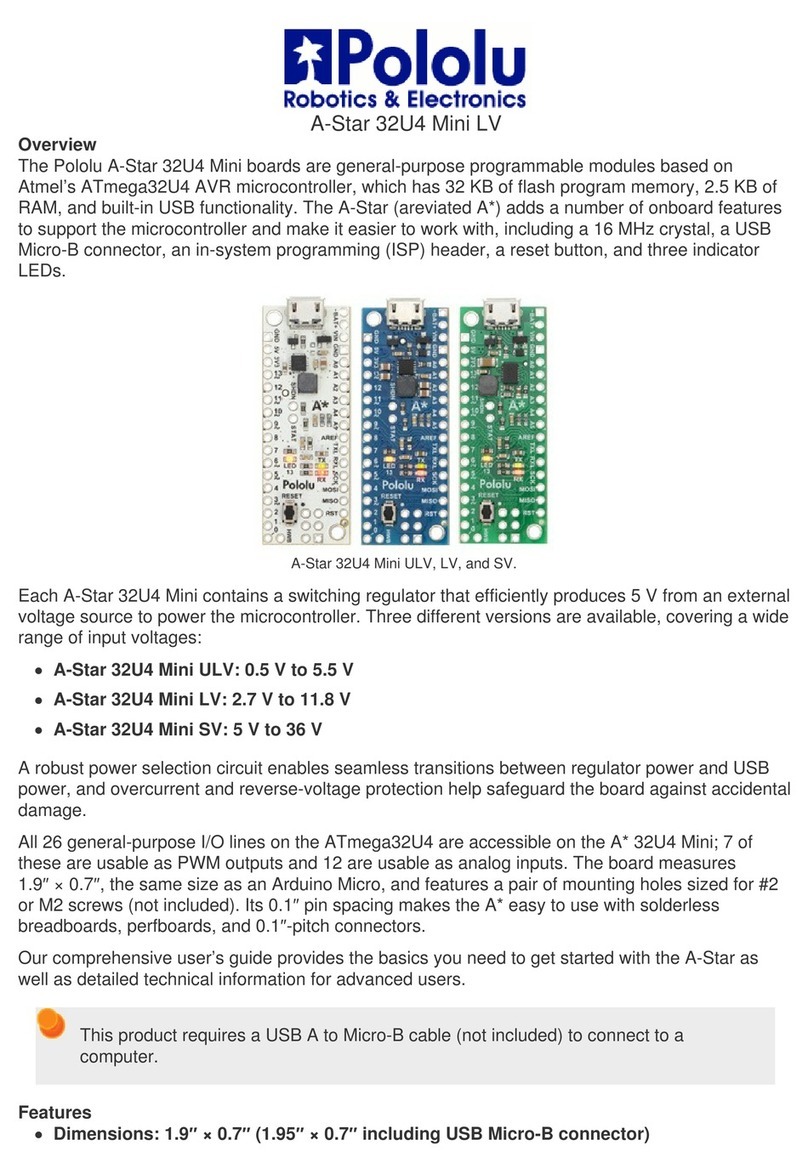
Pololu
Pololu A-Star 32U4 Series manual


